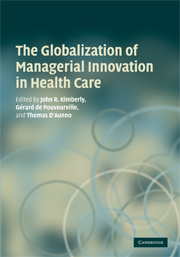Book contents
- Frontmatter
- Contents
- List of figures
- List of tables
- List of contributors
- Acknowledgements
- Introduction
- 1 Origins of DRGs in the United States: A technical, political and cultural story
- 2 Casemix in the United Kingdom: From development to plans
- 3 Casemix implementation in Portugal
- 4 From naïve hope to realistic conviction: DRGs in Sweden
- 5 Casemix in Denmark
- 6 DRGs in France
- 7 Introduction and use of DRGs in Belgium
- 8 DRGs in Germany: Introduction of a comprehensive, prospective DRG payment system by 2009
- 9 Casemix in Switzerland
- 10 The first decade of casemix in Italy
- 11 Casemix development and implementation in Australia
- 12 Diagnosis procedure combination: The Japanese approach to casemix
- 13 Casemix in Singapore
- 14 Experiences with the application of the DRG principle in Hungary
- 15 Casemix systems – past, present, and future: The Canadian experience
- 16 Conclusions: The global diffusion of casemix
- Index
13 - Casemix in Singapore
Published online by Cambridge University Press: 24 February 2010
- Frontmatter
- Contents
- List of figures
- List of tables
- List of contributors
- Acknowledgements
- Introduction
- 1 Origins of DRGs in the United States: A technical, political and cultural story
- 2 Casemix in the United Kingdom: From development to plans
- 3 Casemix implementation in Portugal
- 4 From naïve hope to realistic conviction: DRGs in Sweden
- 5 Casemix in Denmark
- 6 DRGs in France
- 7 Introduction and use of DRGs in Belgium
- 8 DRGs in Germany: Introduction of a comprehensive, prospective DRG payment system by 2009
- 9 Casemix in Switzerland
- 10 The first decade of casemix in Italy
- 11 Casemix development and implementation in Australia
- 12 Diagnosis procedure combination: The Japanese approach to casemix
- 13 Casemix in Singapore
- 14 Experiences with the application of the DRG principle in Hungary
- 15 Casemix systems – past, present, and future: The Canadian experience
- 16 Conclusions: The global diffusion of casemix
- Index
Summary
Background
Singapore is a country with a total land area of 699 sq. km (434 sq. miles). The total population is about 4.35 million, with a resident population of 3.55 million in 2005. Singapore has a relatively young population, with only 8.3 percent of the population above 65.
The state of health in Singapore is good by international standards. The infant mortality rate in 2005 stands at 2.1 per 1,000 live births, while average life expectancy is 79.7 years. The leading causes of morbidity and mortality are currently the major non-communicable diseases, with cancer, stroke and cardiovascular disease accounting for approximately 60 percent of all deaths in 2005.
In 2005, Singapore spent about S$7.6 billion, or 3.8 percent of GDP, on healthcare, of which government expenditure on health services was S$1.8 billion, or 0.9 percent of GDP.
Healthcare system
Singapore has a hybrid system of healthcare delivery. The government manages the public healthcare system, while private hospitals and general practitioners comprise the private healthcare system. Private practitioners provide 80 percent of the primary healthcare services, while the public sector polyclinics provide the remaining 20 percent. For the more costly secondary and tertiary hospital care, it is the reverse, with 80 percent of hospital care being provided by the public sector and the remaining 20 percent by the private sector. Patients are free to choose providers within this dual healthcare delivery system.
- Type
- Chapter
- Information
- The Globalization of Managerial Innovation in Health Care , pp. 272 - 283Publisher: Cambridge University PressPrint publication year: 2008



